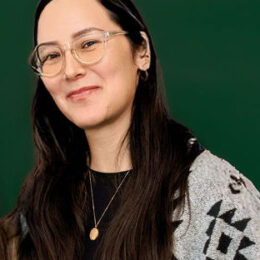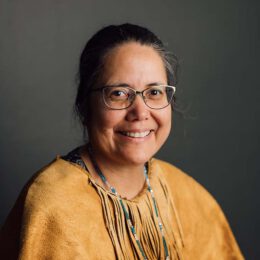
Laura has a B.A. from TRU with a Major in Theatre and a Secwépemc Language Proficiency Diploma from R Stselxméms r Secwépemc. As Language Nest Coordinator, Laura creates an immersive language environment. She is also a playwright, known for her play “Echoes of the Homesick Heart”, created in partnership with Western Canada Theatre, that brings the nuances of language, identity, and community to light.

Candice is Secwépemc from St̓uxtéws. She began her language journey during the pandemic with taking online classes taught by two Elders from her community. Nine months later, she packed up her things in Vancouver to attend the adult immersion program at R Stselxméms r Secwépemc in Adams Lake. Candice works in the Chief Atahm language nest and is currently assisting in the development of a grammar resource for Secwepemctsín immersion teachers.

Dr. Kathryn Michel has worked extensively in the area of community language revitalization and Indigenous language immersion education. She is one of the founding parents of Chief Atahm School, a Secwépemc language immersion program in 1991 on the Adams Lake Reserve near Chase, BC. Dr. Michel holds a Doctorate in Education from UBC and a Master of Arts in Education degree from SFU. She has written, edited and published numerous language curriculum resources for use in Secwepemc immersion classrooms. In 2013, she developed the “First Nations Language Essentials” curriculum guides for use in language programs in First Nations Schools across BC. Currently she is lead instructor for R Stselxméms r Secwépemc Institute language programs through NVIT and UBCO.
Chief Atahm School’s language nest was started in 1987 inspired by the Te Kohanga Reo movement of the Maori in New Zealand. For many decades we were fortunate to have dedicated mother tongue speaking Elders to surround the babies with language. For the last few years, we have been staffing our nest with those who have learned the Secwépemc language as adults. Our language nest team is made up of one advanced-level speaker who had worked for many years with the Elders, and three language nest workers who do the bulk of the administrative and daily tasks such as childcare and cooking. As it is essential that each staff member be committed to the immersion environment, we have provided language training for staff in addition to their work at the nest. Without this commitment to maintaining an “all Secwépemc language environment” it is too easy for English to creep into the nest. In this workshop, we will share some strategies of how to build and maintain an English-free language nest environment, even if your staff is still learning the language themselves.
Helping families raise amazing children in our beautiful Secwepemc language and culture. Call today for a tour or to talk about what our program can offer you and your family.